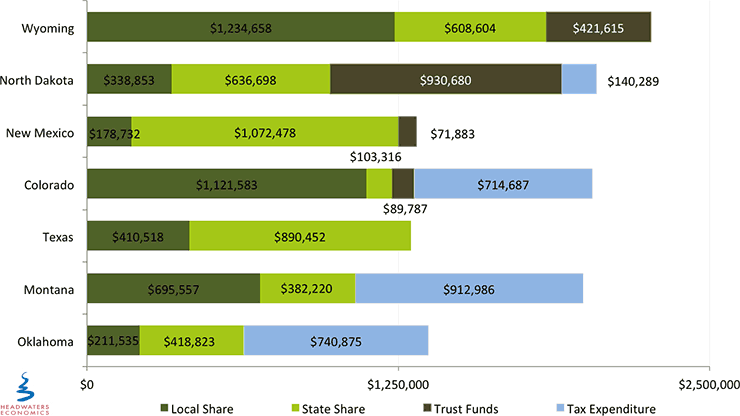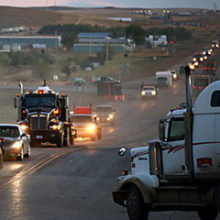Fiscal policy is important for local communities for several reasons, and this analysis shows that many Montana communities are not receiving the resources necessary to build and maintain infrastructure and to provide services during the boom. The Montana report is part of a larger series that looks at major energy producing states.
The focus on unconventional oil is important as horizontal drilling and hydraulic fracturing technologies have led a resurgence in oil production in the U.S. Unconventional oil plays require more wells to be drilled on a continuous basis to maintain production than comparable conventional oil fields. This expands potential employment, income, and tax benefits, but also heightens and extends public costs.
Mitigating the acute impacts associated with drilling activity and related population growth requires that revenue is available in the amount, time, and location necessary to build and maintain infrastructure and to provide services. In addition, managing volatility over time requires different fiscal strategies, including setting aside a portion of oil revenue in permanent funds.
Summary Findings
- Montana’s effective tax rate on a new unconventional oil well is 7.6 percent after ten years of production, ranking third of seven oil-producing states. The state taxes the working interest and non-working interests in a well at different rates, and offers a drilling incentive tax rate of 0.5 percent for 18 months (see Figure 1 below).
- But distributions are delayed by up to 22 months from the start of production by the tax incentive. Distributions are only made to county governments and school districts, leaving cities with few direct revenues to manage impacts associated with drilling and related population growth.
- The share of revenue varies from county to county based on local mill levies. Montana allocates a share of production tax revenue to counties in lieu of local property tax collections. Counties receive from between 39 to 69.5 percent of the revenue generated locally, with the total distribution from production tax collections at about 50 percent.
- Montana does not save any oil production tax revenue in a trust fund for any purpose. Instead, the state chooses to spend oil production tax revenue annually, the largest share going to tax expenditures (46%). This means Montana is highly exposed to revenue volatility and could end up with lower funding if prices or production busts because property tax relief is guaranteed at a minimum level while production tax revenue to pay for it is not (see Figure 2 below).
Figure 1. Comparison of Production Tax Revenue Collected from a Typical Unconventional Oil Well

Figure 2. Comparison of Distribution of Production Tax Revenue from a Typical Unconventional Oil Well

Background
Unconventional oil is extracted from tight shale formations using horizontal drilling and hydraulic fracturing technologies. The focus on unconventional oil is important as horizontal drilling and hydraulic fracturing technologies have led a resurgence in oil production in the U.S. Unconventional oil plays require more wells to be drilled on a continuous basis to maintain production than comparable conventional oil fields. This expands potential employment, income, and tax benefits, but also heightens and extends impacts on communities and public costs.
State and local governments levy different types of production taxes, at different rates, and offer a complex array of exemptions, deductions, and incentives. The various approaches to taxing oil and natural gas make comparisons between states difficult, although not impossible. This report applies each state’s fiscal policy, including production taxes and revenue distributions, to a typical new unconventional oil well over ten years of production. This allows for a comparison of how states tax oil extracted using unconventional technologies, and how this revenue is distributed to communities over time.
To provide a simple framework for the comparison, we assess state production tax policies on four criteria: the amount, time, location, and predictability of revenue distributions to local governments where extraction and associated impacts occur. We also provide a summary of the methods and data used to compare state fiscal policies.
The various approaches to taxing oil make comparisons between states difficult, although not impossible. To compare states, we apply each state’s fiscal policy, including production taxes and revenue distributions, to a typical unconventional oil well. This allows for a comparison of how states tax oil extracted using unconventional technologies, and how this revenue is distributed to communities.
We hope these data and resources will be useful to states and communities with unconventional oil development that are trying to mitigate the short-term impacts of oil extraction while making investments in long-term economic development opportunities.




